Surrounding Rocks Deformation Mechanism and Roof Cutting-Grouting Joint Control Technology for Soft and Thick Coal Seam Roadway
Abstract
:1. Introduction
2. Roadway Deformation and Failure Characteristics
Engineering Background
3. Stress Distribution Characteristics and Failure Mechanism of Roadway Surrounding Rocks
3.1. Equivalent Load Calculation Model of Surrounding Rock Stress Distribution
3.2. Numerical Simulation of Stress Evolution Law on the Surrounding Rock in the Mining Gateway
4. The Design of the Roadway Control Plan by Roof Cutting and Parameters Optimization
4.1. Surrounding Rock Deformation Law with the Change in Roof Cutting Parameters in Soft and Thick Coal Beds
4.2. Experimental Design of the Deformation Response Surface in the Mining Gateway for Pre-Splitting Pressure Relief
4.3. Analysis of the Influence of Changes in Roof Cutting Key Factors on Roadway Sidewall Displacement
5. Joint Control Technology of Roof Cutting-Grouting and Coal Pillar Instability Control Effect
5.1. Mechanism of Roadway Protection by Pre-Splitting Pressure Relief and Coal Pillar Grouting Reinforcement
5.2. Numerical Simulation of Prevention and Treatment of Roadway Deformation and Instability
5.3. Analysis of Deformation and Failure Characteristics of Coal Pillars and Roadway Surrounding Rocks
5.4. Analysis of Deformation and Instability Prevention and Control Effect
6. Discussion
7. Conclusions
Author Contributions
Funding
Institutional Review Board Statement
Informed Consent Statement
Data Availability Statement
Conflicts of Interest
References
- Kang, H.; Yin, K. Simulation study on dilatant and rheologic properties of soft rocks surrounding deep roadway and its application. Mei T’an Hsueh Pao J. China Coal Soc. 2023, 48, 15–33. [Google Scholar] [CrossRef]
- Sun, Y.; Li, G.; Zhang, J.; Xu, J. Failure mechanisms of rheological coal roadway. Sustainability 2020, 12, 2885. [Google Scholar] [CrossRef]
- Lin, W.; Cheng, J.; Li, D.; Dang, H. Deformation characteristics and control technology of roadway in water-rich soft rock. Geofluids 2022, 2022, 2234334. [Google Scholar] [CrossRef]
- Cai, J.; Tu, M.; Zhang, H. Deformation and instability mechanism and control technology of mining gateway for Jurassic weak-cemented soft rock roadways. J. Min. Saf. Eng. 2020, 37, 1114–1122. [Google Scholar] [CrossRef]
- Liu, S.; Bai, J.; Wang, X.; Yan, S.; Zhao, J. Field and numerical study on deformation and failure characteristics of deep high-stress main roadway in Dongpang Coal Mine. Sustainability 2021, 13, 8507. [Google Scholar] [CrossRef]
- Zhao, B.; Wang, F.; Liang, N.; Wang, W. Reasonable segment pillar width and its control technology for fully mechanized top-coal caving face with high stress. J. Min. Saf. Eng. 2018, 35, 19–26. [Google Scholar] [CrossRef]
- Guo, Y.; Zheng, X.; Guo, G.; Zhao, Q.; Zhou, W.; An, T. Study on deformation failure and control of surrounding rock in soft rock roadway in close range coal seam with overhead mining. J. Min. Saf. Eng. 2018, 35, 1142–1149. [Google Scholar] [CrossRef]
- Ju, J.; Xu, J.; Wang, Q. Cantilever structure moving type of key strata and its influence on ground pressure in large mining height workface. J. China Coal Soc. 2011, 36, 2115–2120. [Google Scholar] [CrossRef]
- Wang, K.; Xing, K.; Fan, L.; Yang, G.; Zou, Y.; Jiang, J. Study on numerical simulation of strata-pressure behaviors in fully-mechanized caving face. China Energy Environ. Prot. 2020, 42, 170–174. [Google Scholar] [CrossRef]
- Lian, X.; Li, C.; Li, J.; Wu, L. Law of strata pressure behavior of surrounding rock in nearby goaf roadway for extra-thick coal seams of Datong Mine Area. Front. Earth Sci. 2023, 10, 1015378. [Google Scholar] [CrossRef]
- Wang, H.; Li, S.; Li, W.; Li, H.; Li, Z. Failure mechanism of roadway surrounding rock in deep thick coal seam and its support optimization. J. Min. Saf. Eng. 2012, 29, 631–636. [Google Scholar]
- Kang, H.; Lin, J.; Wu, Y. High pretensioned stress and intensive cable bolting technology setinfull section and application in entry affected by dynamic pressure. Mei T’an Hsueh Pao J. China Coal Soc. 2009, 34, 1153–1159. [Google Scholar]
- He, M.; Wang, Y.; Yang, J.; Zhou, P.; Gao, Q. Comparative analysis on stress field distributions in roof cutting nonpillar mining method and conventional mining method. J. China Coal Soc. 2018, 43, 626–637. [Google Scholar] [CrossRef]
- Sun, Q.; Ma, F.; Guo, J.; Li, G.; Feng, X. Deformation failure mechanism of deep vertical shaft in Jinchuan Mining Area. Sustainability 2020, 12, 2226. [Google Scholar] [CrossRef]
- Wang, X.; Zhang, Y.; Zhang, Q.; Wei, Y.; Liu, W.; Jiang, T. Space-time evolution characteristics of deformation and failure of surrounding rock in deep soft rock roadway. Sustainability 2022, 14, 12587. [Google Scholar] [CrossRef]
- Tian, C.; Liu, Y.; Lou, H.; Jia, T. Stability Control of a Roadway Surrounding Rock during the Cutting and Pressure Relief of a Coal-Bearing Roof at a Shallow Mining Depth. Geofluids 2022, 2022, 5308530. [Google Scholar] [CrossRef]
- Cheng, L.; Xu, J.; Lu, T. Effects of Tectonic Stress on Stability of Dilatancy Characteristic Soft Rock Roadway Intersection in Deep Underground. Disaster Adv. 2012, 5, 1190–1195. [Google Scholar]
- Zhan, Q.; Zheng, X.; Du, J.; Xiao, T. Coupling instability mechanism and joint control technology of soft-rock roadway with a buried depth of 1336 m. Rock Mech. Rock Eng. 2020, 53, 2233–2248. [Google Scholar] [CrossRef]
- Kang, H.; Lin, J.; Fan, M.J. Investigation on Support pattern of a coal mine roadway within soft rocks—A case study. Int. J. Coal Geol. 2015, 140, 31–40. [Google Scholar] [CrossRef]
- Kang, H.; Feng, Z. Status and development tendency of roadway grunting reinforcement technology in coal mine. J. Min. Strat. Control Eng. 2013, 18, 1–7. [Google Scholar] [CrossRef]
- Sun, Y.; Li, G.; Zhang, J.; Sun, J.; Huang, J.; Taherdangkoo, R. New insights of grouting in coal mass: From small-scale experiments to microstructures. Sustainability 2021, 13, 9315. [Google Scholar] [CrossRef]
- Ma, X.; He, M.; Li, X.; Wang, E.; Hu, C.; Gao, R. Deformation mechanism and control measures of overlying strata with gob-side entry retaining formed by roof cutting and pressure releasing. J. Min. Saf. Eng. 2019, 48, 474–483. [Google Scholar] [CrossRef]
- Yang, H.; Zhang, N.; Han, C.; Sun, C.; Song, G.; Sun, Y.; Sun, K. Stability control of deep coal roadway under the pressure relief effect of adjacent roadway with large deformation: A case study. Sustainability 2021, 13, 4412. [Google Scholar] [CrossRef]
- Chi, B.; Zhou, K.; He, M.; Yang, J.; Wang, Q.; Ma, X. Optimization research on supporting parameters of roof cutting entry retaining with large mining height face. Meitan Kexue Jishu 2017, 45, 128–133. [Google Scholar] [CrossRef]
- Chen, S.; Guo, Z.; Ma, Z.; Hu, J.; Wang, J.; Zhu, S.; Zhang, M. Research on parameters optimization of cumulative blasting used in cutting roof in Chengjiao Coal Mine. Coal Technol. 2016, 35, 17–19. [Google Scholar] [CrossRef]
- Fan, D.; Liu, X.; Tan, Y.; Song, S.; Gu, Q.; Yan, L.; Xu, Q. Roof cutting parameters design for gob-side entry in deep coal mine: A case study. Energies 2019, 12, 2032. [Google Scholar] [CrossRef]
- Xi, P.; Zhu, D.; Huo, Y.; Xing, C.; Wang, Z. Numerical investigation of the failure mechanism and countermeasures of the roadway surrounding rockmass within deep soft rock. Int. J. Multiscale Comput. Eng. 2022, 20, 17–41. [Google Scholar] [CrossRef]
- Yang, S.-Q.; Chen, M.; Jing, H.-W.; Chen, K.-F.; Meng, B. A case study on large deformation failure mechanism of deep soft rock roadway in Xin’An Coal Mine, China. Eng. Geol. 2017, 217, 89–101. [Google Scholar] [CrossRef]
- Yang, H.; Li, Y.; Liu, Y.; Cao, S.; Pan, R.; Wang, H.; Wang, B.; Chen, X.; Zhao, X. Structure evolution and stability control mechanism of hard-roof cutting for roadway retaining. J. Min. Saf. Eng. 2021, 38, 766–773. [Google Scholar] [CrossRef]
- Gao, M. Study on surrounding rock control technology of gob-side entry of cutting roof for compound roof in soft coal seam. Coal Technol. 2021, 40, 41–45. [Google Scholar] [CrossRef]
- Li, Y.; Hua, X.; Cai, R. Mechanics Analysis on the stability of key block in the gob-side entry retaining and engineering application. J. Min. Saf. Eng. 2012, 29, 357–364. [Google Scholar]
- Chen, S.; Zhao, F.; Wang, H.; Yuan, G.; Guo, Z.; Yang, J. Determination of key parameters of gob-side entry retaining by cutting roof and its application to a deep mine. Rock Soil Mech. 2019, 40, 332–342+350. [Google Scholar] [CrossRef]
- Yang, Z.; Ding, Y.; Gao, X. Experimental study on mechanical response failure mechanism of dynamic pressure roadway based on roof cutting and pressure releasing technology. Saf. Coal Mines 2021, 52, 47–53. [Google Scholar] [CrossRef]
- Kikumoto, M.; Vu, P.Q.N.; Yasuhara, H.; Kishida, K. Constitutive Model for Soft Rocks Considering Structural Healing and Decay Structural Healing. Comput. Geotech. 2017, 91, 93–103. [Google Scholar] [CrossRef]
- Pan, Y.; Zhang, H.; Hao, Z.; Zhang, G.; Chen, S.; Wang, L. Engineering Properties of Soft Rock with High Geostress and the Performance Under Excavation of Deep Tunnel. Arab. J. Sci. Eng. 2022, 47, 13349–13364. [Google Scholar] [CrossRef]
- Zhang, B.; Wang, H.; Wang, P.; Yu, G.; Gu, S. Experimental and theoretical study on the dynamic effective stress of loaded gassy coal during gas release. Int. J. Min. Sci. Technol. 2023, 33, 339–349. [Google Scholar] [CrossRef]
- Chen, Y.; Teng, J.; Bin Sadiq, R.A.; Zhang, K. Experimental Study of Bolt-Anchoring Mechanism for Bedded Rock Mass. Int. J. Geomech. 2020, 20, 04020019. [Google Scholar] [CrossRef]
- Yuan, W.; Hong, K.; Liu, R.; Ji, L.; Meng, L. Numerical simulation of coupling support for high-stress fractured soft rock roadway in deep mine. Adv. Civ. Eng. 2022, 2022, 7221168. [Google Scholar] [CrossRef]
- Zhang, H.; Li, Y.; Wang, X.; Yu, S.; Wang, Y. Study on Stability Control Mechanism of Deep Soft Rock Roadway and Active Support Technology of Bolt-Grouting Flexible Bolt. Minerals 2023, 13, 409. [Google Scholar] [CrossRef]
- Jing, W.; Liu, S.; Yang, R.; Jing, L.; Xue, W. Mechanism of aging deformation zoning of surrounding rock in deep high stress soft rock roadway based on rock creep characteristics. J. Appl. Geophys. 2022, 202, 104632. [Google Scholar] [CrossRef]
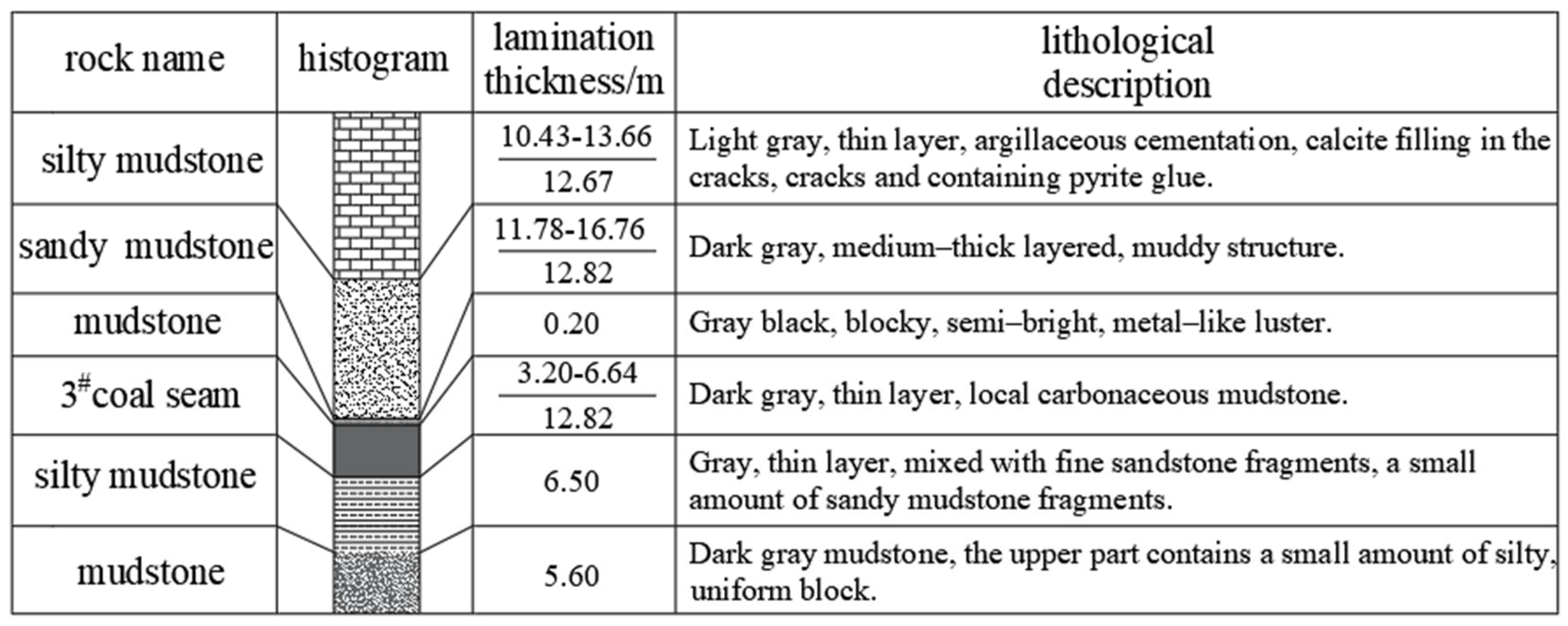
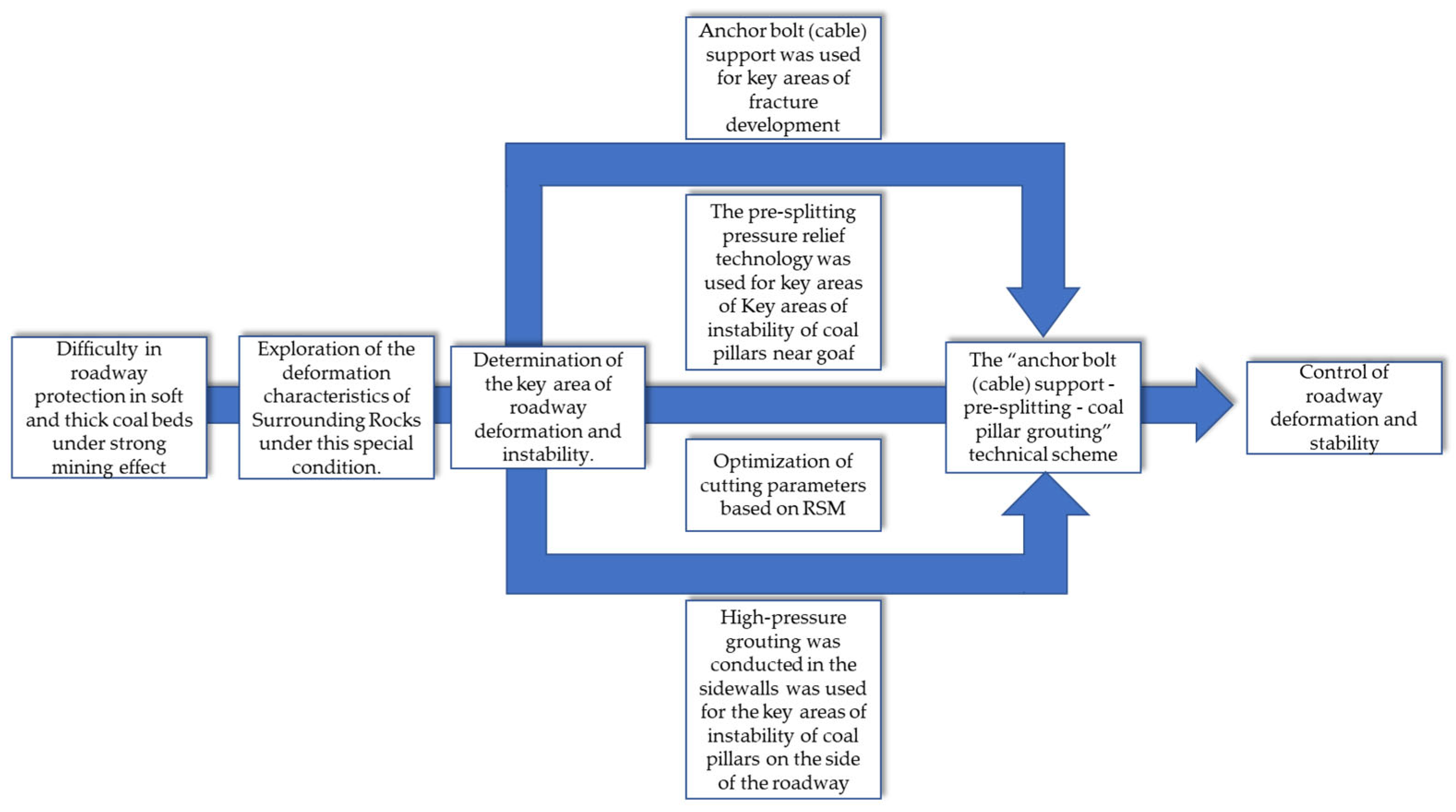
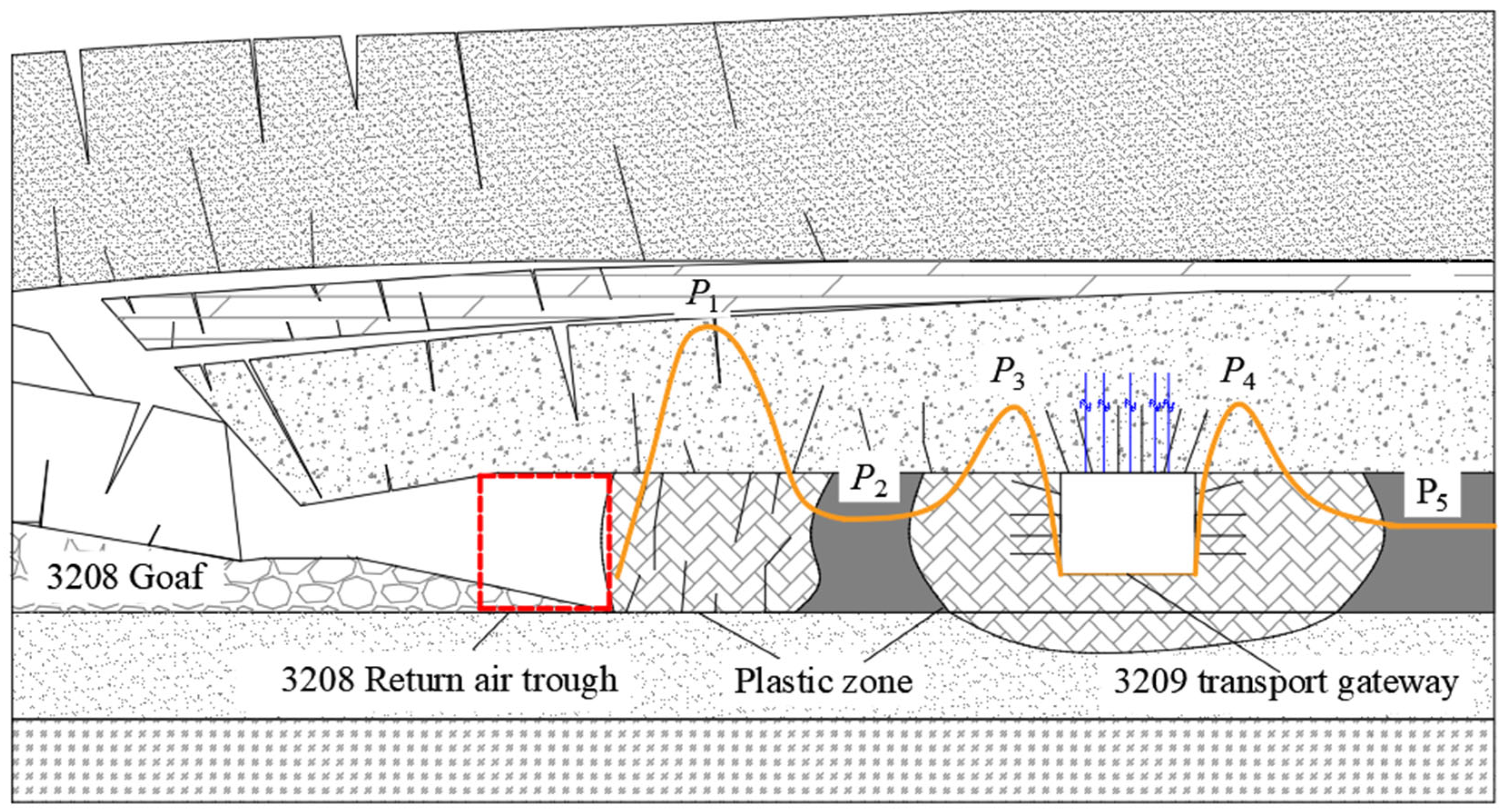
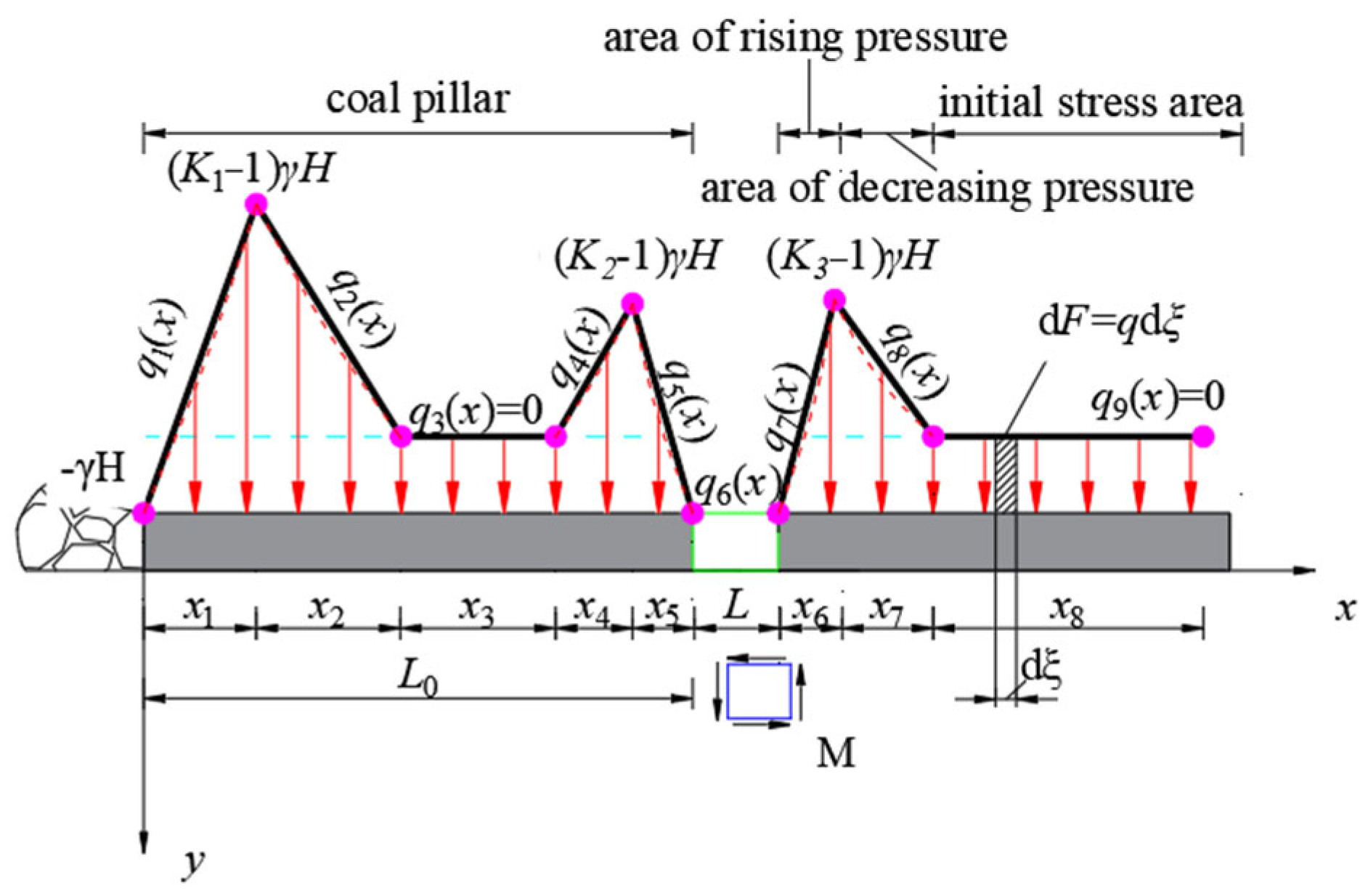
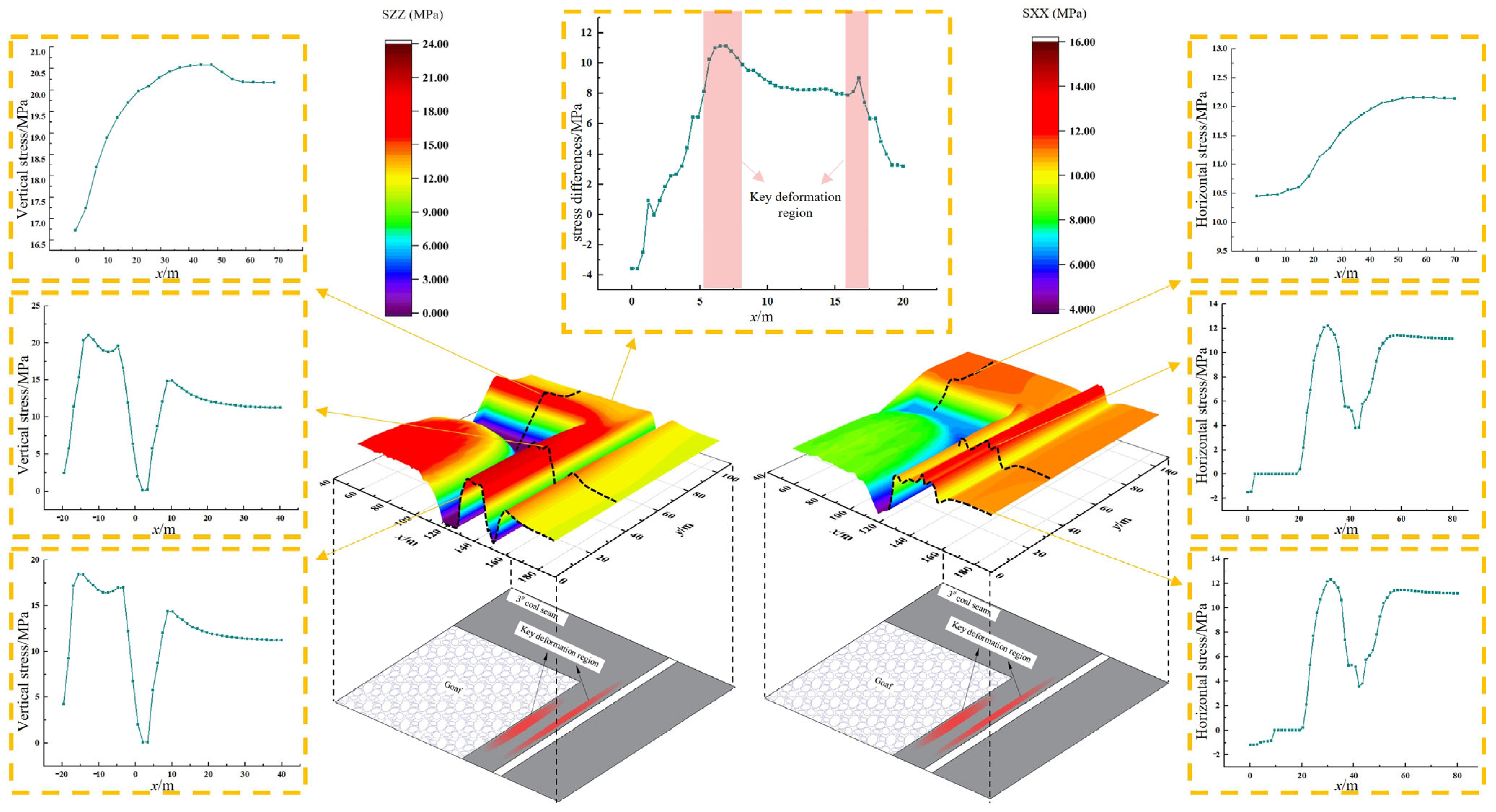
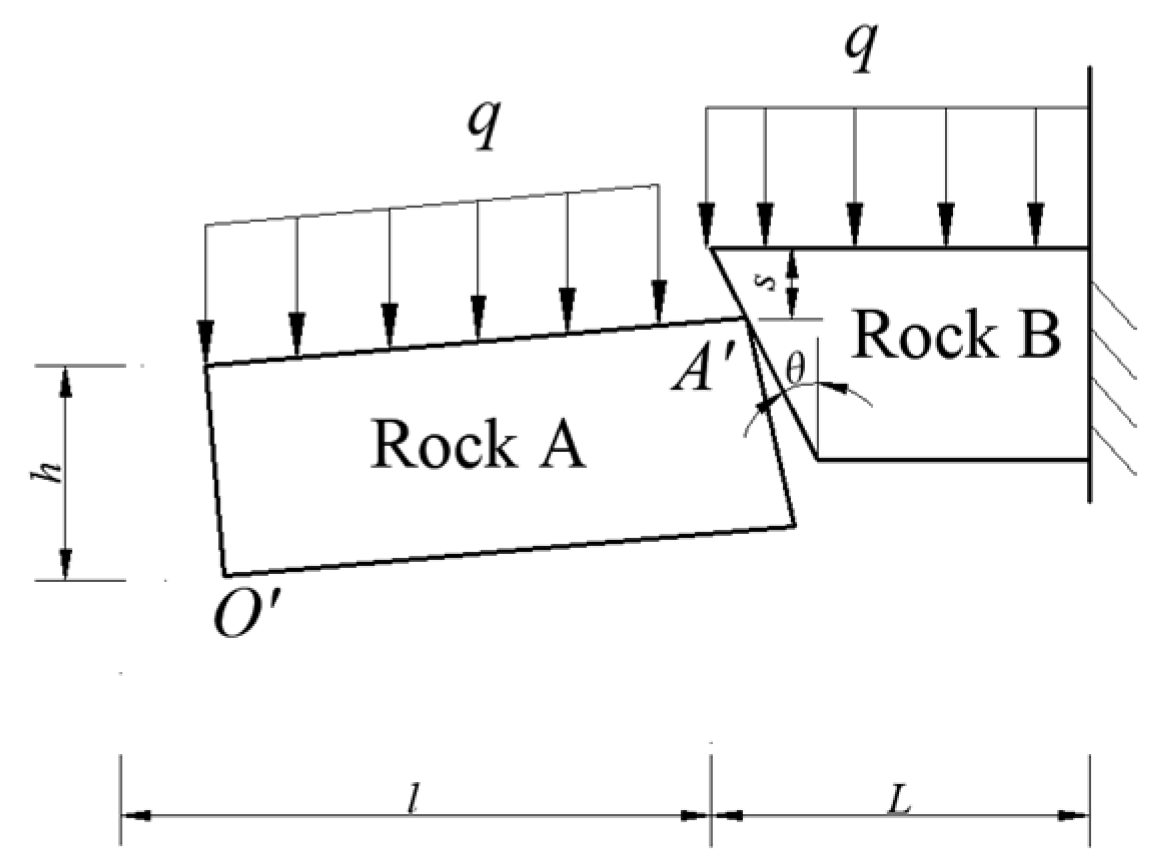
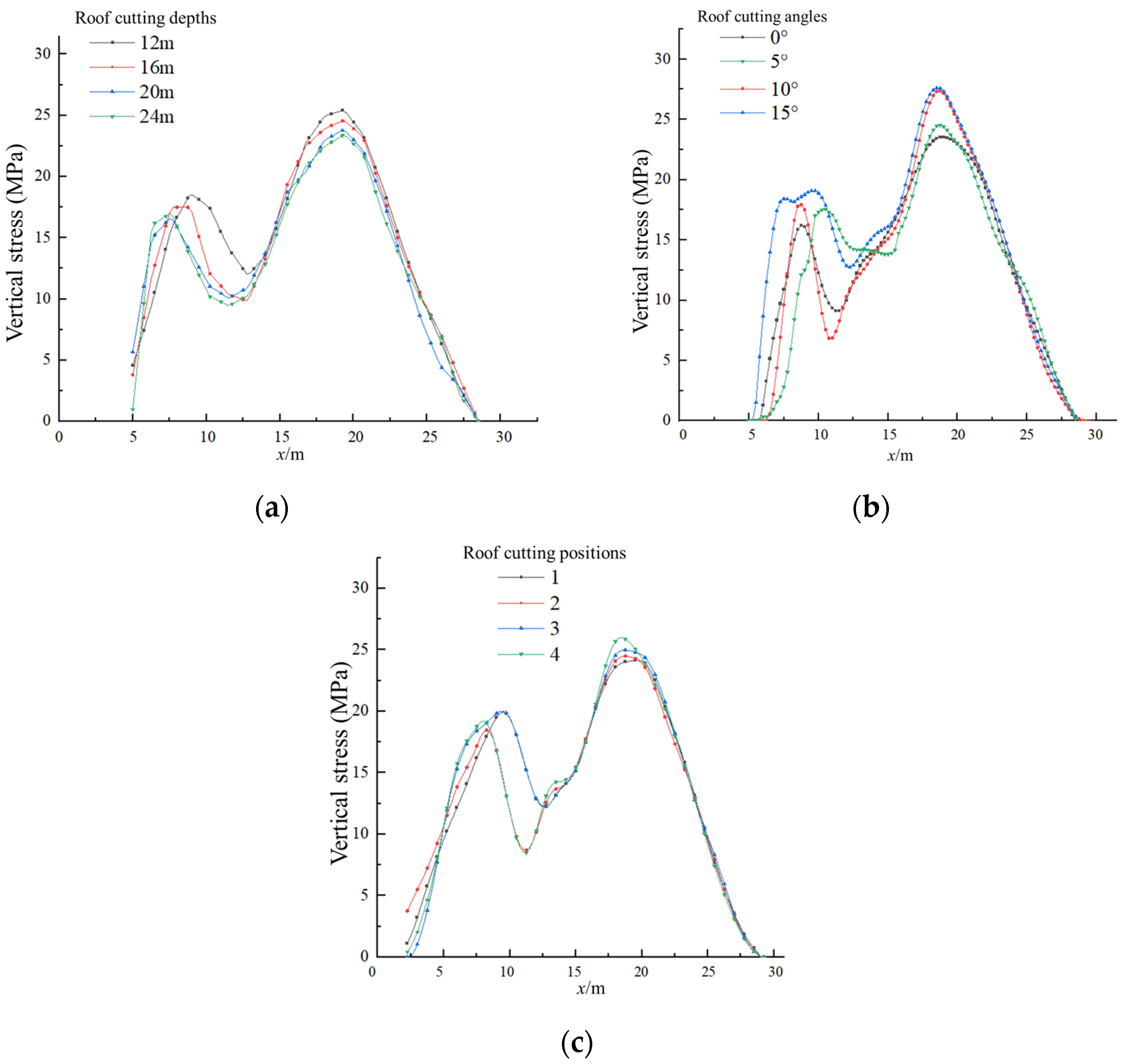

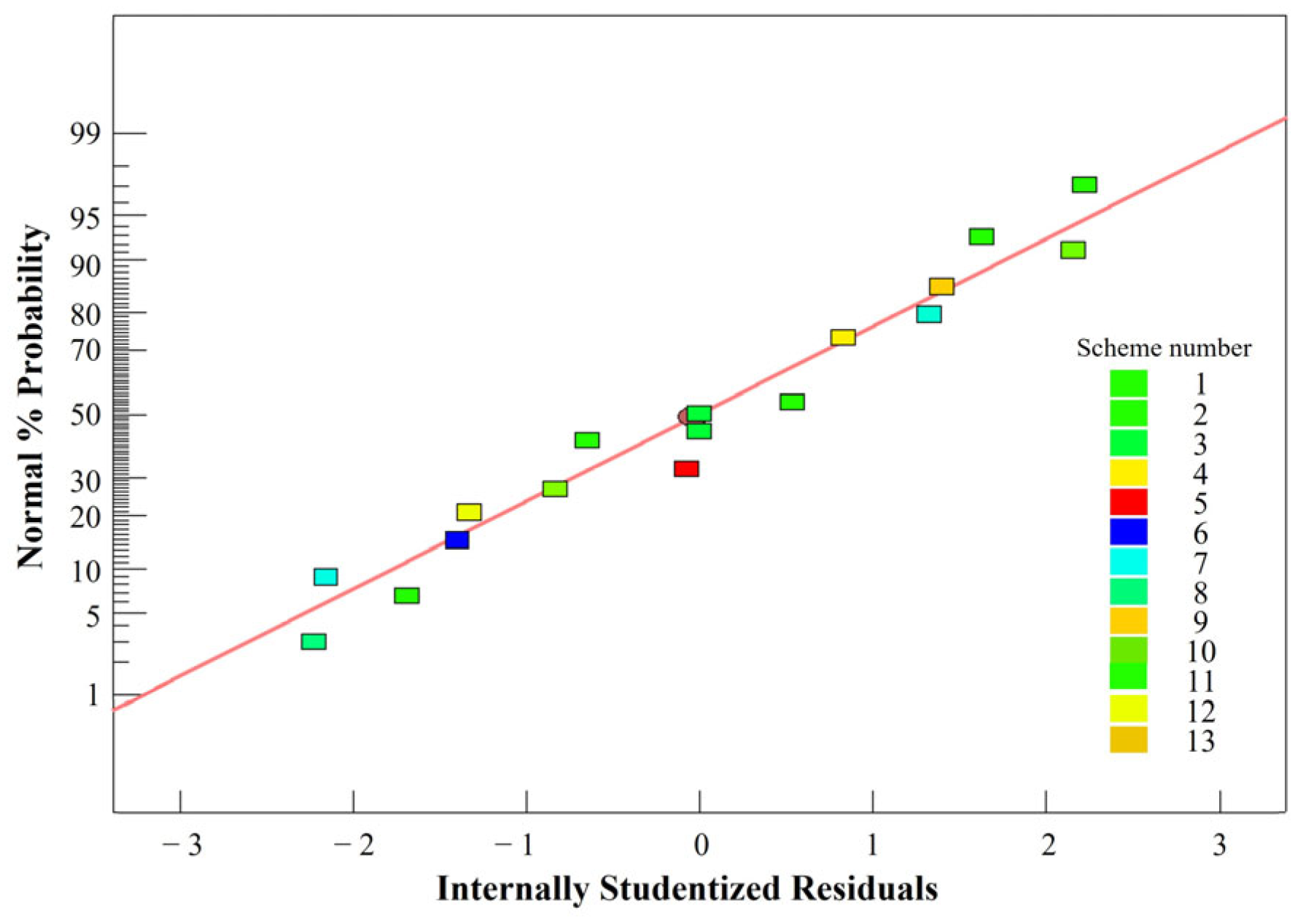
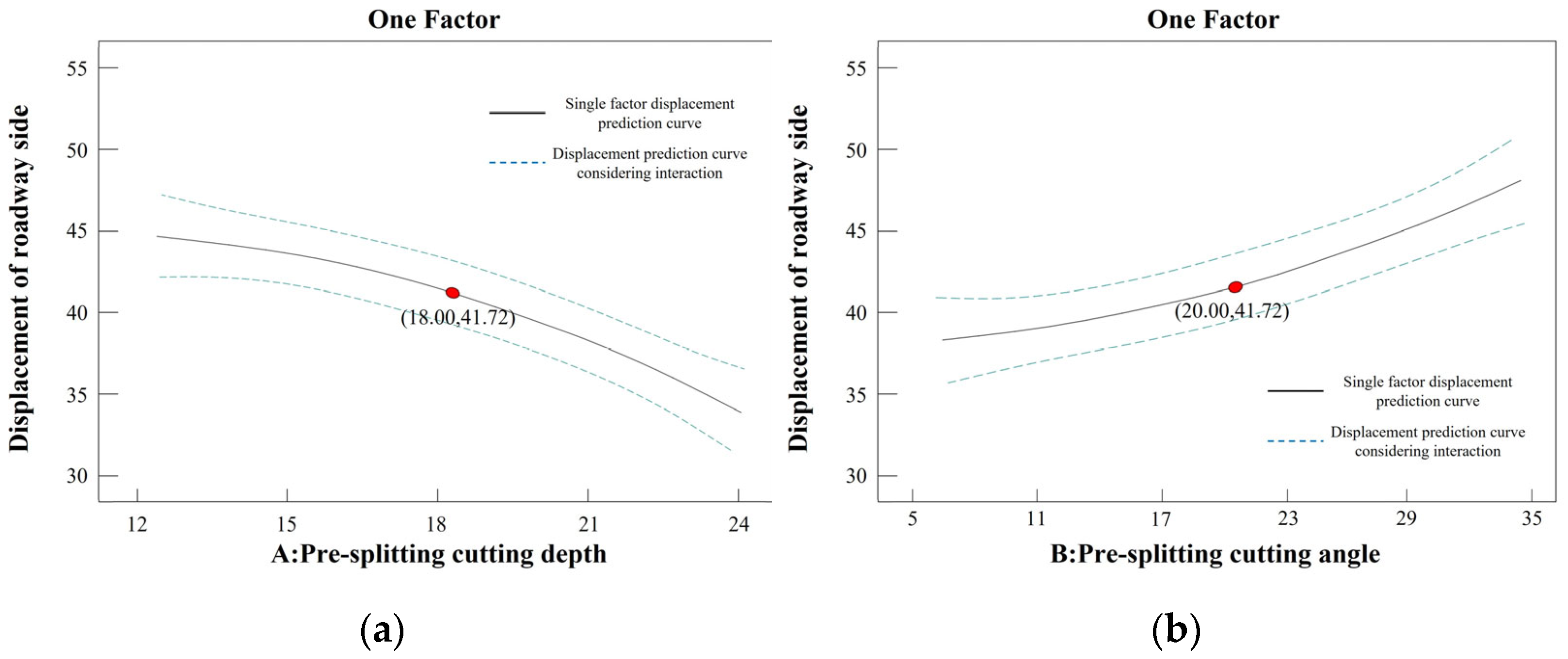
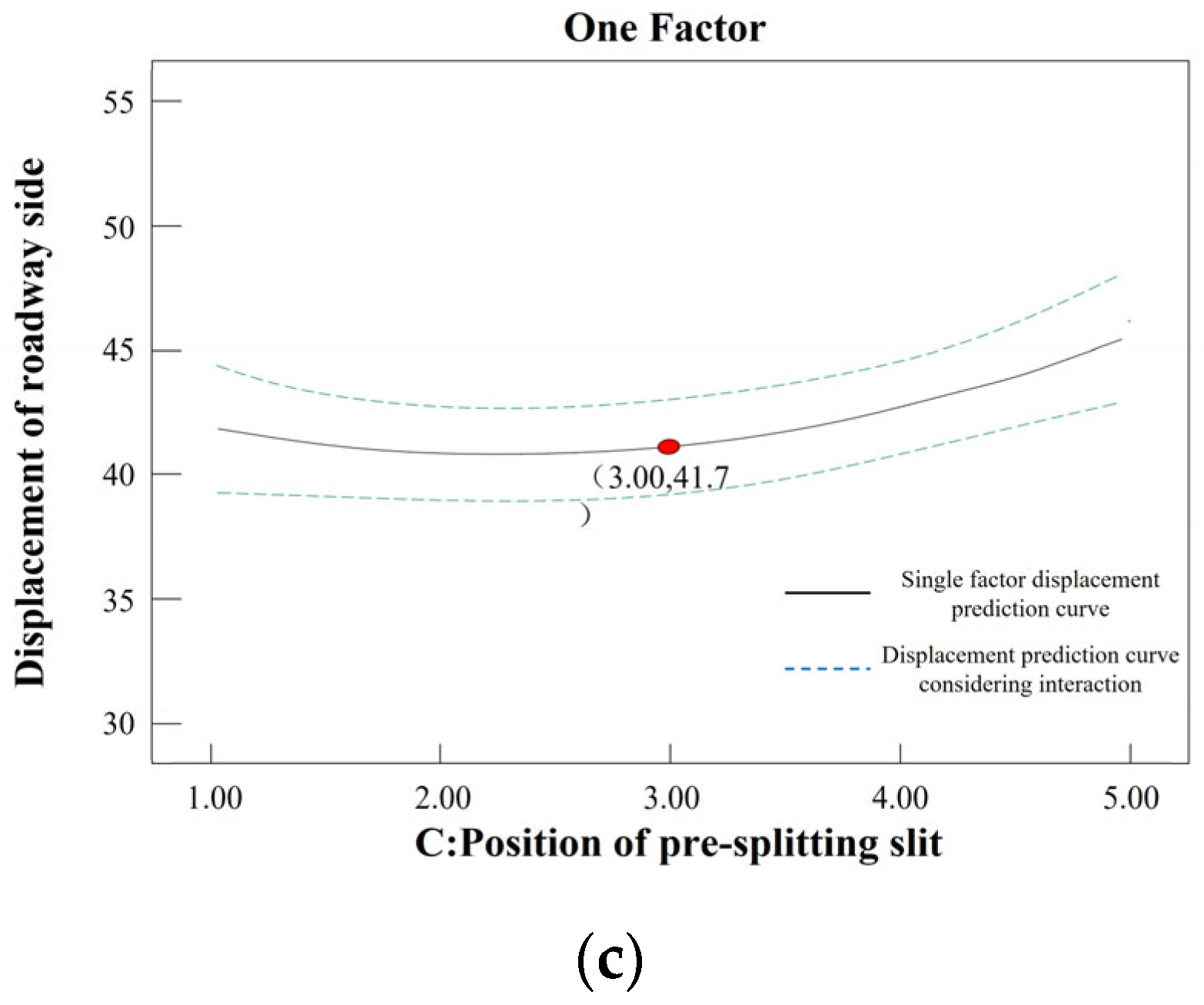
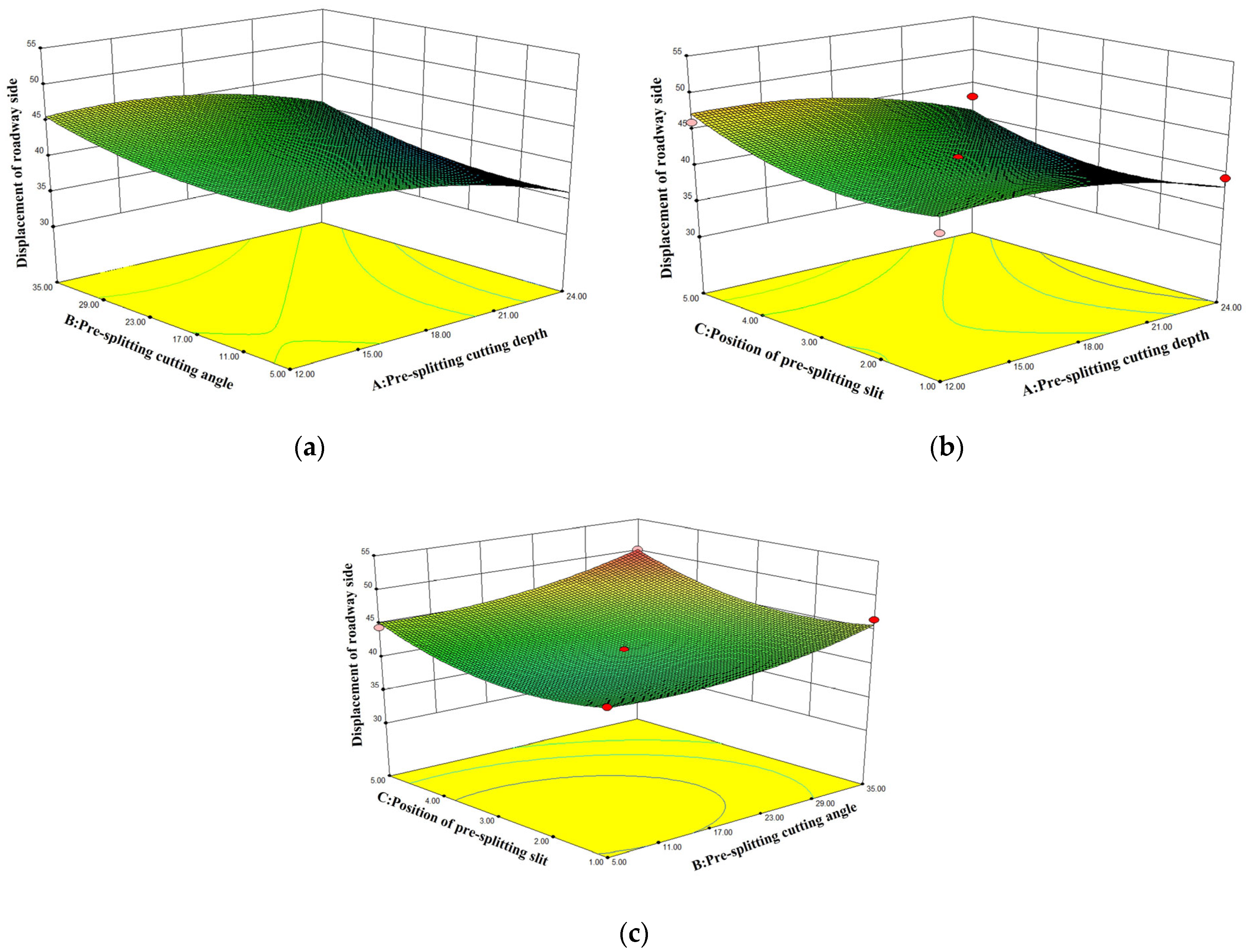
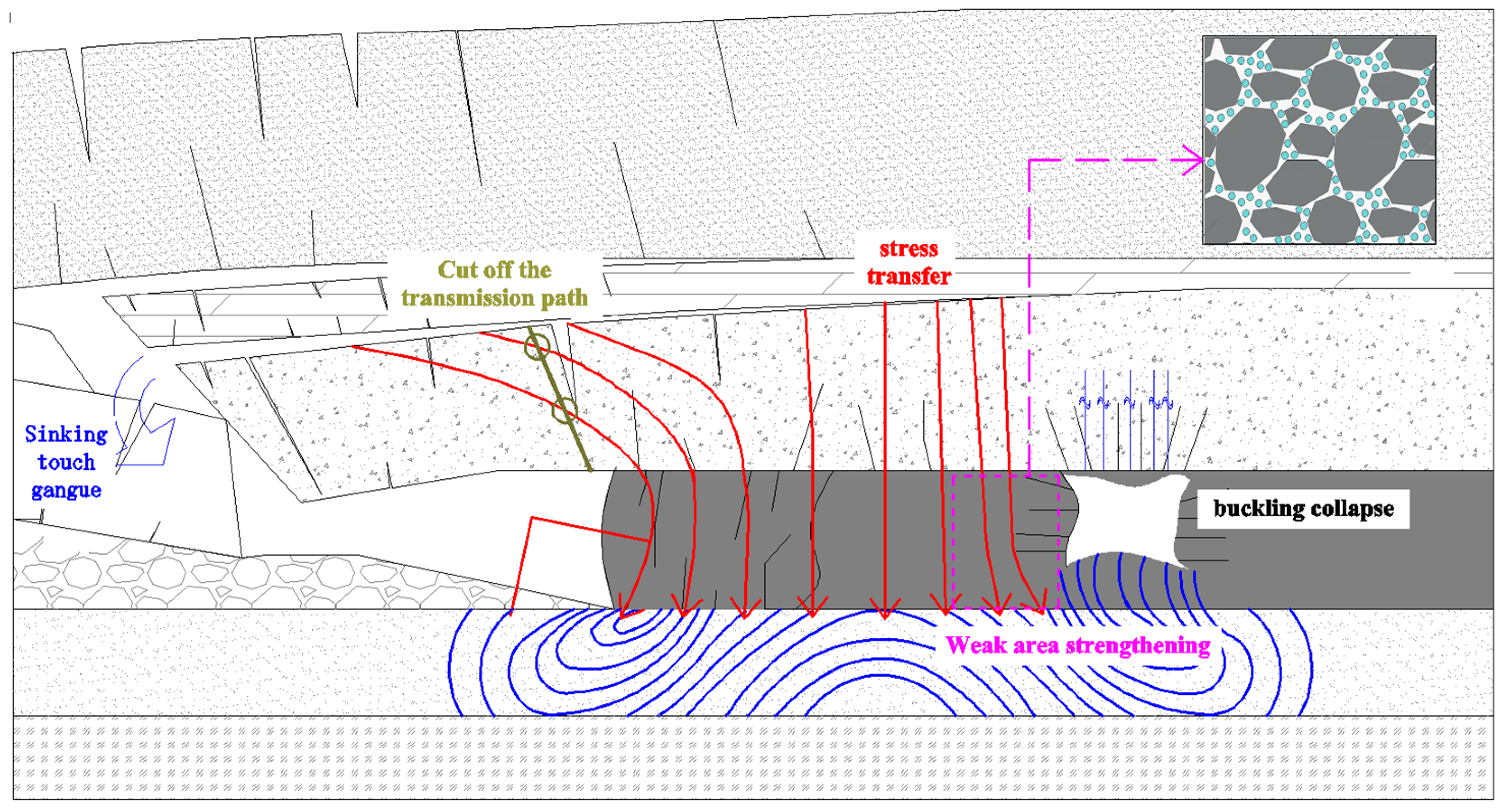
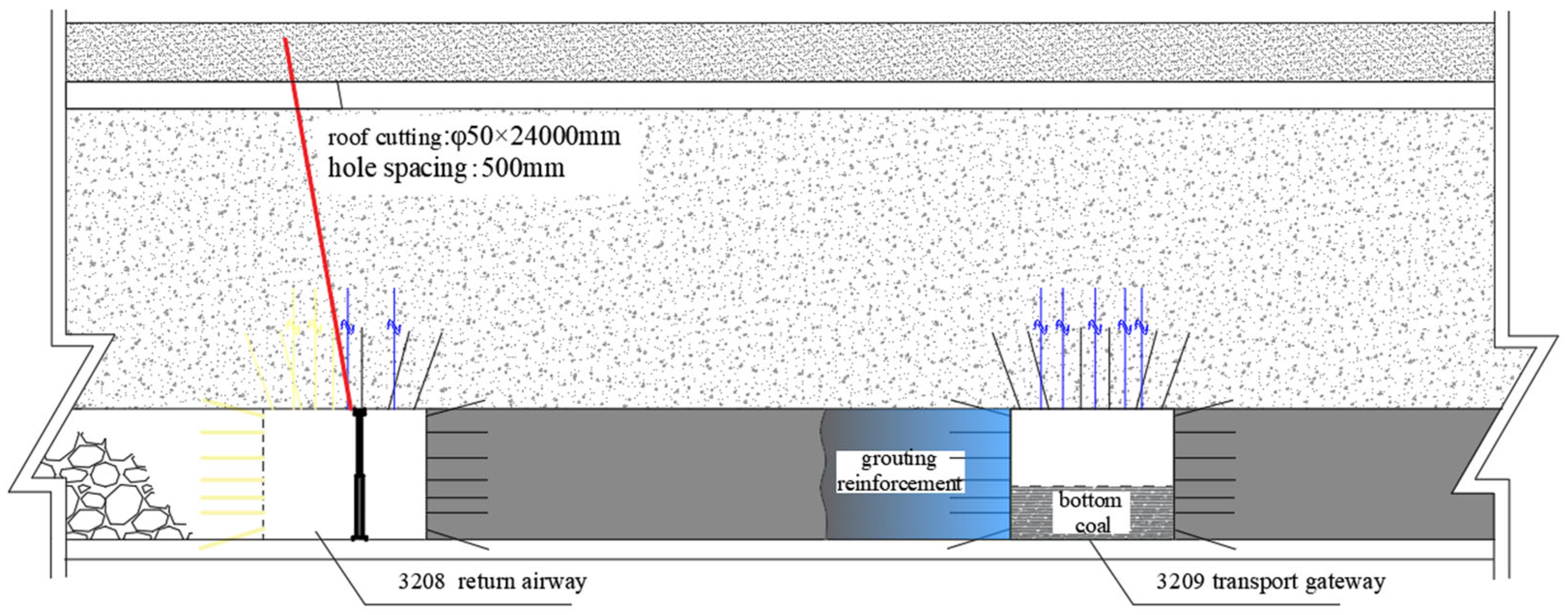


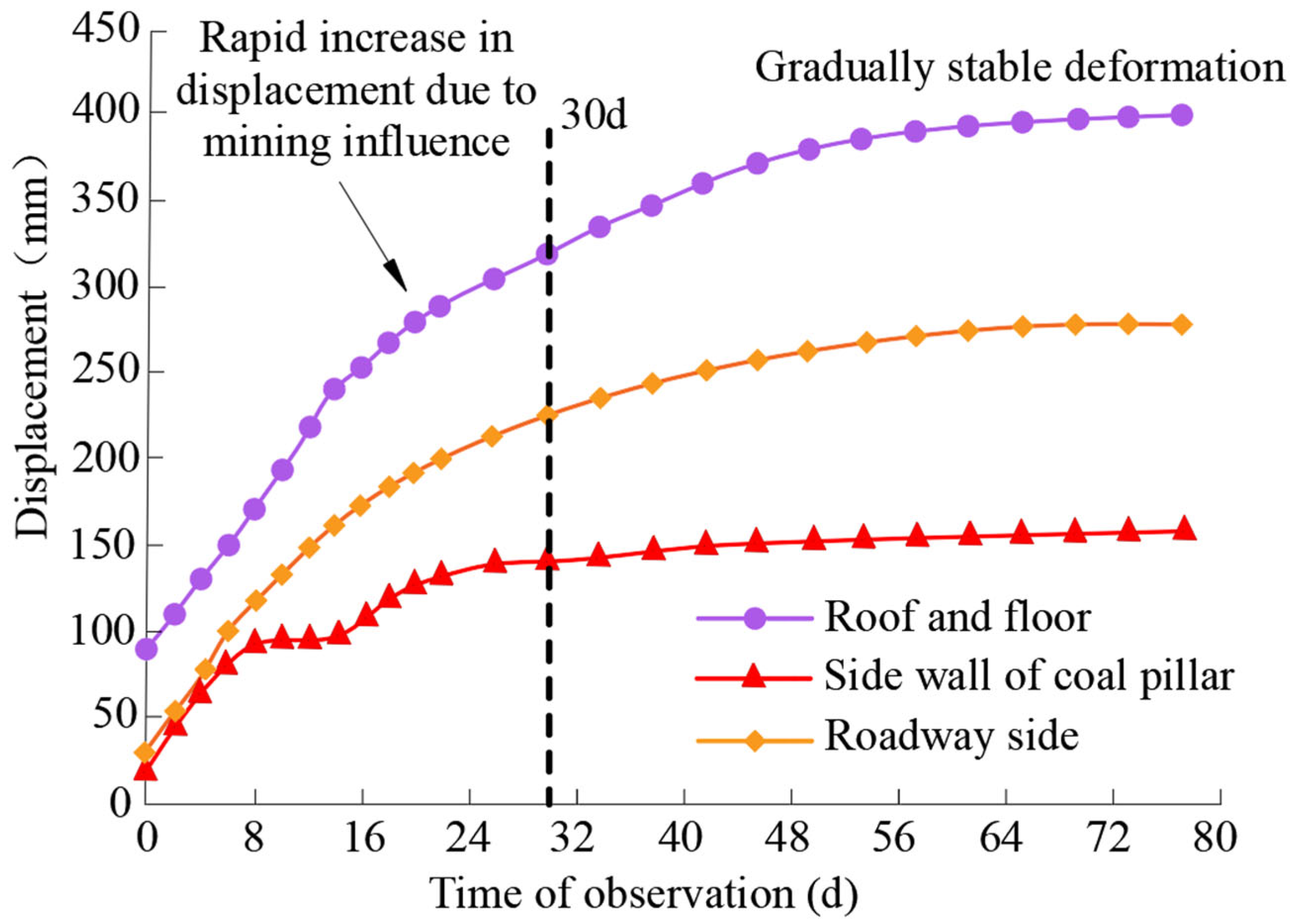
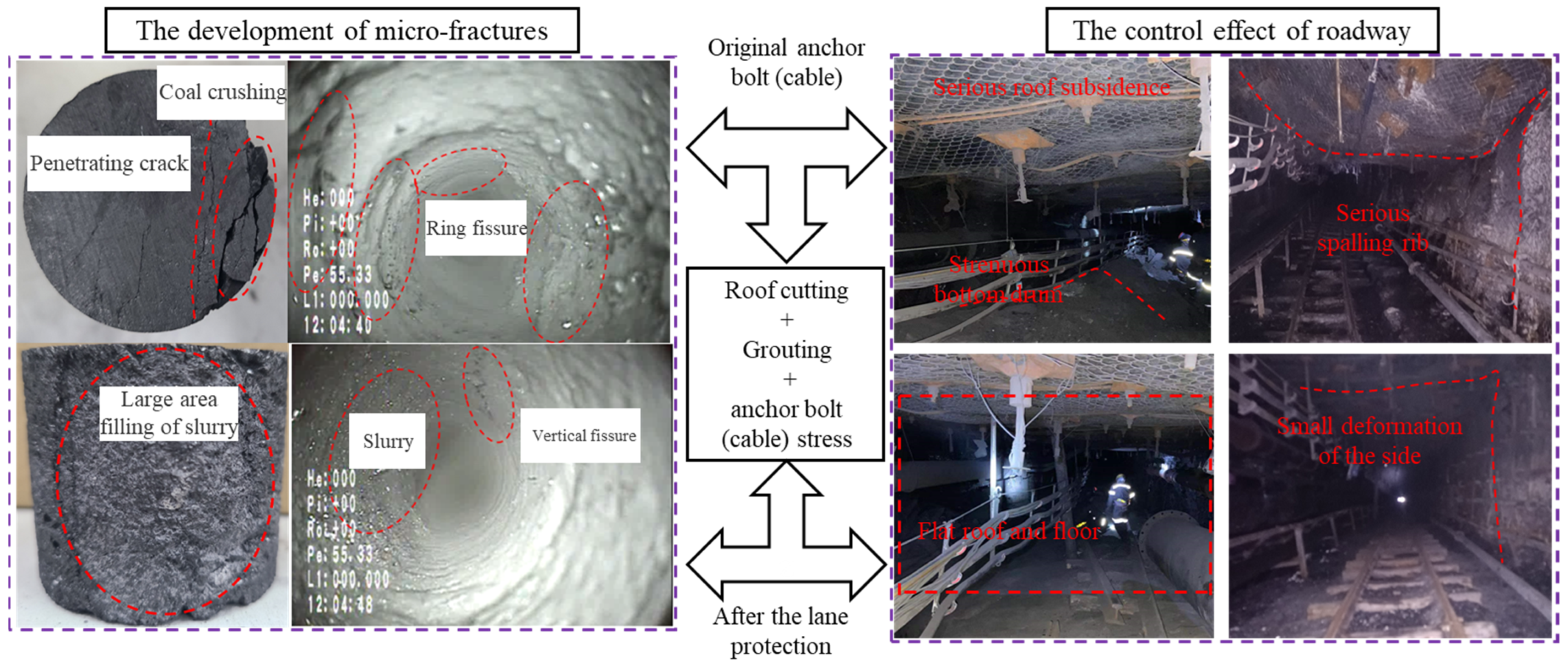
| The Distance of Gateway | On-Site Observation of Deformation Characteristics | On-Site Deformation Characteristics |
|---|---|---|
| 0–300 m |  | The roof and floor of the section were flat; the sidewalls slightly bulged; the overall roadway deformation was small, and the maximum surface displacement was less than 500 mm. |
| 300–400 m | 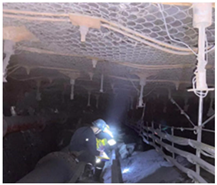 | The section’s roadway convergence enlarged; the sidewall deformation was severe; the maximum sidewall heave reached 1100 mm. |
| 650–850 m | 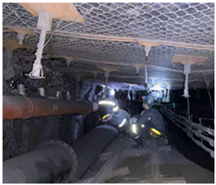 | The coal pillar sidewalls bulged severely, and some metal meshes were torn; the anchor bolts were extruded and deformed. The floor heave reached 1800 mm, and the roadway height was only 1.4 m. |
| 400–650 m | 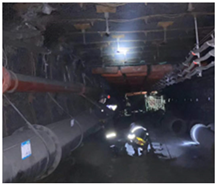 | The roof movement tended to be stable. After repairs, the roadway deformation was small; the sidewalls, roof, and floor were flat. |
| Lithology | Density /kg·m−3 | Bulk Modulus /Gpa | Shear Modulus /Gpa | Cohesion /Mpa | Tensile Strength /Mpa | Internal Friction Angle/° |
|---|---|---|---|---|---|---|
| Fine sandstone | 2597 | 8.6 | 4.9 | 6.2 | 2.01 | 36 |
| Siltstone | 2575 | 7.1 | 4.9 | 2.3 | 1.72 | 34 |
| Sandy mudstone | 2500 | 5.0 | 3.29 | 1.11 | 1.65 | 31 |
| Medium sandstone | 2530 | 11.0 | 12.4 | 5.75 | 3.12 | 37 |
| Sandy mudstone | 2500 | 5.0 | 3.29 | 1.11 | 1.65 | 31 |
| 3# coal | 1400 | 3.64 | 1.87 | 0.60 | 1.26 | 28 |
| Silty mudstone | 2520 | 4.7 | 2.08 | 1.45 | 1.78 | 27 |
| Sandy mudstone | 2500 | 5.0 | 3.29 | 1.11 | 1.65 | 31 |
| Mudstone | 2529 | 2.3 | 2.41 | 1.05 | 1.3 | 29 |
| Siltstone | 2575 | 7.1 | 4.9 | 2.3 | 1.72 | 34 |
| Mudstone | 2529 | 2.3 | 2.41 | 1.05 | 1.3 | 29 |
| Factor Level | Roof Cutting Position (m) | Roof Cutting Angle (°) | Roof Cutting Depth (m) |
|---|---|---|---|
| 1 | 1.0 | 5 | 12 |
| 2 | 3.0 | 15 | 16 |
| 3 | 5.0 | 25 | 24 |
| Scheme | Roof Cutting Depth (m) | Roof Cutting Angle (m) | Roof Cutting Position (m) | Roadway Sidewall Displacement (m) |
|---|---|---|---|---|
| 1 | 12 | 5 | 3 | 44.22 |
| 2 | 24 | 5 | 3 | 34.84 |
| 3 | 12 | 25 | 3 | 47.09 |
| 4 | 24 | 25 | 3 | 39.12 |
| 5 | 12 | 15 | 1 | 40.68 |
| 6 | 24 | 15 | 1 | 39.37 |
| 7 | 12 | 15 | 5 | 46.06 |
| 8 | 24 | 15 | 5 | 43.07 |
| 9 | 18 | 5 | 1 | 42.34 |
| 10 | 18 | 25 | 1 | 46.59 |
| 11 | 18 | 5 | 5 | 44.50 |
| 12 | 18 | 25 | 5 | 50.19 |
| 13 | 18 | 15 | 3 | 41.72 |
| Source | Sum of Squares | Df | Mean Square | F-Value | p-Value | Notes |
|---|---|---|---|---|---|---|
| Model | 178.53 | 9 | 19.84 | 5.87 | 0.0146 | significant |
| A—roof cutting depth | 58.63 | 1 | 58.63 | 17.37 | 0.0042 | |
| B—roof cutting angle | 36.50 | 1 | 36.50 | 10.81 | 0.0133 | |
| C—roof cutting distance | 27.54 | 1 | 27.54 | 8.16 | 0.0245 | |
| AB | 0.50 | 1 | 0.50 | 0.15 | 0.7128 | |
| AC | 0.70 | 1 | 0.70 | 0.21 | 0.6619 | |
| BC | 0.51 | 1 | 0.51 | 0.15 | 0.7079 | |
| A2 | 16.95 | 1 | 16.95 | 5.02 | 0.0600 | |
| B2 | 10.86 | 1 | 10.86 | 3.22 | 0.1160 | |
| C2 | 28.00 | 1 | 28.00 | 8.29 | 0.0237 | |
| Residual | 23.63 | 7 | 3.38 | |||
| Lack of Fit | 23.63 | 3 | 7.88 | 3.62 | 0.12 | not significant |
Disclaimer/Publisher’s Note: The statements, opinions and data contained in all publications are solely those of the individual author(s) and contributor(s) and not of MDPI and/or the editor(s). MDPI and/or the editor(s) disclaim responsibility for any injury to people or property resulting from any ideas, methods, instructions or products referred to in the content. |
© 2023 by the authors. Licensee MDPI, Basel, Switzerland. This article is an open access article distributed under the terms and conditions of the Creative Commons Attribution (CC BY) license (https://creativecommons.org/licenses/by/4.0/).
Share and Cite
Zhang, X.; Wang, F.; Qu, H.; Liu, C.; Li, Z.; Hao, W. Surrounding Rocks Deformation Mechanism and Roof Cutting-Grouting Joint Control Technology for Soft and Thick Coal Seam Roadway. Sustainability 2023, 15, 15415. https://doi.org/10.3390/su152115415
Zhang X, Wang F, Qu H, Liu C, Li Z, Hao W. Surrounding Rocks Deformation Mechanism and Roof Cutting-Grouting Joint Control Technology for Soft and Thick Coal Seam Roadway. Sustainability. 2023; 15(21):15415. https://doi.org/10.3390/su152115415
Chicago/Turabian StyleZhang, Xutong, Fangtian Wang, Hongfei Qu, Chao Liu, Zhe Li, and Wenhua Hao. 2023. "Surrounding Rocks Deformation Mechanism and Roof Cutting-Grouting Joint Control Technology for Soft and Thick Coal Seam Roadway" Sustainability 15, no. 21: 15415. https://doi.org/10.3390/su152115415
APA StyleZhang, X., Wang, F., Qu, H., Liu, C., Li, Z., & Hao, W. (2023). Surrounding Rocks Deformation Mechanism and Roof Cutting-Grouting Joint Control Technology for Soft and Thick Coal Seam Roadway. Sustainability, 15(21), 15415. https://doi.org/10.3390/su152115415







